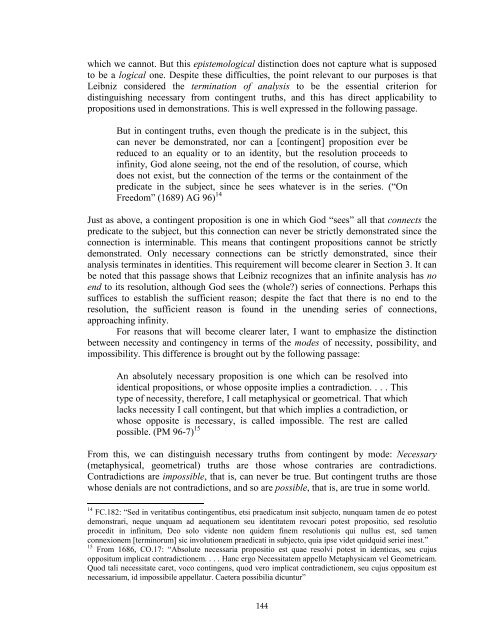Stony Brook University
Stony Brook University
Stony Brook University
Create successful ePaper yourself
Turn your PDF publications into a flip-book with our unique Google optimized e-Paper software.
which we cannot. But this epistemological distinction does not capture what is supposed<br />
to be a logical one. Despite these difficulties, the point relevant to our purposes is that<br />
Leibniz considered the termination of analysis to be the essential criterion for<br />
distinguishing necessary from contingent truths, and this has direct applicability to<br />
propositions used in demonstrations. This is well expressed in the following passage.<br />
But in contingent truths, even though the predicate is in the subject, this<br />
can never be demonstrated, nor can a [contingent] proposition ever be<br />
reduced to an equality or to an identity, but the resolution proceeds to<br />
infinity, God alone seeing, not the end of the resolution, of course, which<br />
does not exist, but the connection of the terms or the containment of the<br />
predicate in the subject, since he sees whatever is in the series. (“On<br />
Freedom” (1689) AG 96) 14<br />
Just as above, a contingent proposition is one in which God “sees” all that connects the<br />
predicate to the subject, but this connection can never be strictly demonstrated since the<br />
connection is interminable. This means that contingent propositions cannot be strictly<br />
demonstrated. Only necessary connections can be strictly demonstrated, since their<br />
analysis terminates in identities. This requirement will become clearer in Section 3. It can<br />
be noted that this passage shows that Leibniz recognizes that an infinite analysis has no<br />
end to its resolution, although God sees the (whole?) series of connections. Perhaps this<br />
suffices to establish the sufficient reason; despite the fact that there is no end to the<br />
resolution, the sufficient reason is found in the unending series of connections,<br />
approaching infinity.<br />
For reasons that will become clearer later, I want to emphasize the distinction<br />
between necessity and contingency in terms of the modes of necessity, possibility, and<br />
impossibility. This difference is brought out by the following passage:<br />
An absolutely necessary proposition is one which can be resolved into<br />
identical propositions, or whose opposite implies a contradiction. . . . This<br />
type of necessity, therefore, I call metaphysical or geometrical. That which<br />
lacks necessity I call contingent, but that which implies a contradiction, or<br />
whose opposite is necessary, is called impossible. The rest are called<br />
possible. (PM 96-7) 15<br />
From this, we can distinguish necessary truths from contingent by mode: Necessary<br />
(metaphysical, geometrical) truths are those whose contraries are contradictions.<br />
Contradictions are impossible, that is, can never be true. But contingent truths are those<br />
whose denials are not contradictions, and so are possible, that is, are true in some world.<br />
14 FC.182: “Sed in veritatibus contingentibus, etsi praedicatum insit subjecto, nunquam tamen de eo potest<br />
demonstrari, neque unquam ad aequationem seu identitatem revocari potest propositio, sed resolutio<br />
procedit in infinitum, Deo solo vidente non quidem finem resolutionis qui nullus est, sed tamen<br />
connexionem [terminorum] sic involutionem praedicati in subjecto, quia ipse videt quidquid seriei inest.”<br />
15 From 1686, CO.17: “Absolute necessaria propositio est quae resolvi potest in identicas, seu cujus<br />
oppositum implicat contradictionem. . . . Hanc ergo Necessitatem appello Metaphysicam vel Geometricam.<br />
Quod tali necessitate caret, voco contingens, quod vero implicat contradictionem, seu cujus oppositum est<br />
necessarium, id impossibile appellatur. Caetera possibilia dicuntur”<br />
144
















